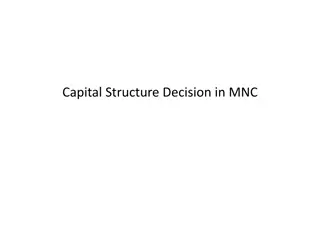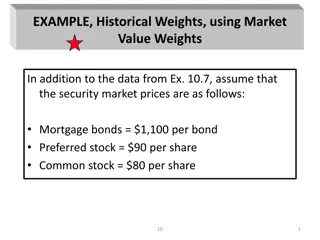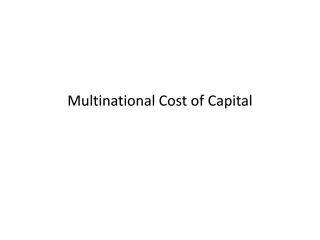Understanding International Capital Structure and Cost of Capital
Explore the concept of international capital structure and its impact on the cost of capital, including discussions on cost of equity, investment decisions, market segmentation, and cross-border financing. Learn how firms can lower their cost of capital through internationalization strategies, such as optimizing ownership structures.
Download Presentation

Please find below an Image/Link to download the presentation.
The content on the website is provided AS IS for your information and personal use only. It may not be sold, licensed, or shared on other websites without obtaining consent from the author. Download presentation by click this link. If you encounter any issues during the download, it is possible that the publisher has removed the file from their server.
E N D
Presentation Transcript
International capital structure and the cost of capital
Sections Cost of capital Segmentation vs. integration Differential costs of capital Cross-border share listing Foreign equity ownership restrictions Subsidiaries capital structure
Cost of capital The cost of capital is the minimum rate of return an investment project must generate in order to pay its financing costs. For a levered firm, the financing costs can be represented by the weighted average cost of capital (WACC): K = (1 )Ke+ (1 )i where K = weighted average cost of capital = debt to total market value ratio Ke = cost of equity capital for a levered firm = marginal corporate income tax rate i = pretax cost of debt
Investment decision and the cost of capital A firm that can reduce its cost of capital will increase the profitable capital expenditures that the firm can take on and increase the wealth of the shareholders. Klocal Kglobal Internationalizing the firm s cost of capital is one such policy. IRR Investment ($) IlocalIglobal
Cost of equity The cost of equity capital (Ke) of a firm is the expected return on the firm s stock that investors require. This return is frequently estimated using the Capital Asset Pricing Model (CAPM): Ri = Rf + i(RM Rf) Cov(Ri ,RM) Var(RM) where i =
Cost of equity: segmentation vs. integration If capital markets are segmented, investors can only invest domestically. This means that the market portfolio (M) in the CAPM formula would be the domestic portfolio instead of the world portfolio. Ri = Rf + i (RU.S. Rf) U.S . versus Ri = Rf + i (RW Rf) W Clearly integration or segmentation of international financial markets has major implications for determining the cost of capital.
Does the cost of capital differ? There do appear to be differences in the cost of capital in different countries. When markets are imperfect (say lack of financial integration and the existence of home bias, quality of corporate governance, etc.), international financing can lower the firm s cost of capital. One way to achieve this is to internationalize the firm s ownership structure.
Cross-border share listings Cross-border listings of stocks have become quite popular among major corporations. The largest contingent of foreign stocks are listed on the London Stock Exchange. U.S. exchanges attracted the next largest contingent of foreign stocks. Examples of foreign firms listed on the NYSE: Canon, Honda, HSBC, China Mobile, UBS, and many more.
Benefits of cross-border listing Expand the firm s potential investor base, which will lead to a higher stock price and lower cost of capital. Create a secondary market for the company s shares, which facilitates raising new capital in foreign markets. Enhance the liquidity of the company s stock. Enhance the visibility of the company s name and its products in foreign marketplaces.
Costs of cross-border listing It can be costly to meet the disclosure and listing requirements. Controlling insiders may find it difficult to continue to derive private benefits once the company is cross- listed on foreign exchanges (due to better governance). There can be volatility spillover from overseas markets. Foreigners may acquire a controlling interest and challenge the domestic control of the company.
The effect of foreign equity ownership restrictions While companies have incentives to internationalize their ownership structure to lower the cost of capital and increase market share, they may be concerned with the possible loss of corporate control to foreigners. In many countries, there are legal restrictions on the percentage of a firm that foreigners can own. These restrictions are imposed as a means of ensuring domestic control of local firms.
Historical restrictions on foreign ownership Country Restrictions on foreigners Canada Limited to 20% in broadcasting; limited to 25% in banking/insurance France Limited to 20% China Foreigners restricted to B shares; locals eligible for A shares Japan Limited to 20-50% for several major firms; acquisition of over 10% of a single firm subject to approval Spain Limited to 0% of defense industries and mass media; limited to 50% of other firms Switzerland Limited to bearer shares United Kingdom Government retains veto power over foreign takeover of any British firm.
Dual pricing Suppose foreigners, if allowed, would like to buy 30 percent of a Korean firm. But because of ownership constraints imposed on foreigners, they can purchase at most 20 percent. Because this constraint is effective in limiting desired foreign ownership, foreign and domestic investors many face different market share prices. This dual pricing is the so-called pricing-to-market (PTM) phenomenon. Dual pricing implies differential cost of equity.
Dual pricing example: Nestl Recall that Nestl used to issue two different classes of common stock: bearer shares and registered shares. Foreigners were only allowed to buy bearer shares. Swiss citizens could buy registered shares. The bearer stock was more expensive. On November 18, 1988, Nestl lifted restrictions imposed on foreigners, allowing them to hold registered shares as well as bearer shares.
Nestl: dual pricing gone Source: Financial Times, November 26, 1988 p.1. Adapted with permission.
Nestls cost of capital Following this, the price spread between the two types of shares narrowed dramatically. This implies that there was a major transfer of wealth from foreign shareholders to Swiss shareholders. The price of bearer shares declined about 25 percent. The price of registered shares rose by about 35 percent. Because registered shares represented about two-thirds of the market capitalization, the total value of Nestl increased substantially when it internationalized its ownership structure. Nestl s cost of capital therefore declined.
Subsidiaries capital structure There are three different approaches to determining a subsidiary s financial structure: Conform to the parent company's norm. Conform to the local norm of the country where the subsidiary operates. Vary judiciously to capitalize on opportunities to lower taxes, reduce financing costs and risk, and take advantage of various market imperfections. Generally speaking, the 3rd approach is most sensible. In addition to differential cost of equity and differential cost of debt, and differential taxes, political risk also should be given due consideration in the choice of a subsidiary s financial structure.
End-of-chapter Questions: 1-3, 6, 9, 10.























